Spider-view: “Revenge of the Sinister Six”
Some poor characterization aside, this second return of the Sinister Six is an explosive, exciting first outing for new Spider-Man writer/artist Erik Larsen
—by Nathan on August 28, 2023—
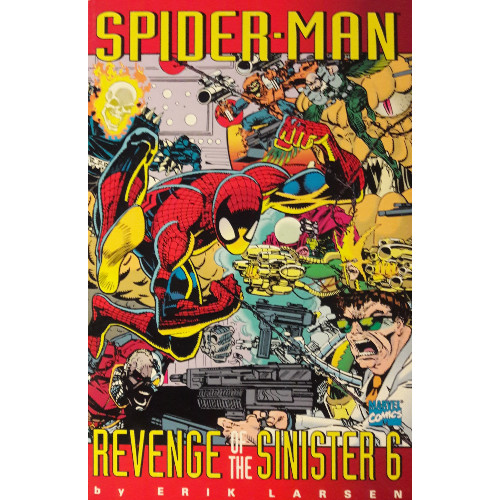
In 1964, a team of six nefarious ne’er-do-wells conspired against a certain Wall-Crawler. Electro, Sandman, Vulture, Mysterio, and Kraven the Hunter jumped Spidey one at a time, oddly enough, each trying to defeat the hero with their own powers and tricks, while team founder and leader Doctor Octopus played host to a kidnapped Betty Brant and Aunt May. Stan Lee and Steve Ditko’s first Amazing Spider-Man annual remains a personal favorite issue of mine, probably my single favorite standalone comics narrative ever produced. Though simple, the story is wonderfully engaging, Ditko’s art masterfully providing full page pin-ups showcasing our hero in the midst of titanic struggles with each adversary.
26 years later, most of the team returned, courtesy of David Michelinie and Erik Larsen. Led again by Doc Ock, the Sandman, Electro, Vulture, Mysterio, and Jason Macendale’s demon-possessed Hobgoblin (replacing the then-deceased Kraven) joined forces to squash that pesky spider…and attempt a little world domination in the process. Duped by Octavius, the team unraveled, Sandman actually turning on the multi-limbed madman and being temporarily transformed into glass.
Fortunately, it wouldn’t take 26 more years for the Six to reunite. With some changes in the lineup, Spidey’s classic crew of cretins reformed a year-and-a-half later. Larsen also made his return, not only penciling and inking the issues but taking over the writing/duties on the “adjectiveless” Spider-Man title from the recently departed Todd McFarlane.
The team had previously returned. Now? They wanted revenge.
“Revenge of the Sinister Six”
Writer: Erik Larsen
Penciler: Erik Larsen
Inker: Erik Larsen
Colorists: Gregory Wright, Joe Rosas
Letterers: Rick Parker, Chris Eliopoulos
Issues: Spider-Man #18-23
Publication Dates: January-June 1992
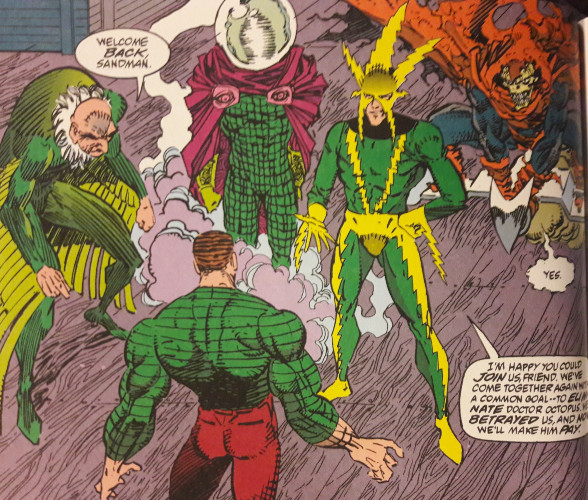
Larsen had already succeeded McFarlane once before–replacing the artist on ASM and penciling narratives such as “Powerless,” “Righteous Sand,” and most of the ASM chapters of “The Cosmic Spider-Man” saga (save for an issue McFarlane illustrated). Leaving ASM after issue #350, Larsen was replaced by Mark Bagley and found his way over to this title, adding words to his pencils and inks.
By and large, Larsen’s writing proves superior to McFarlane’s. I don’t know if, at the time, Larsen’s writing credits were more extensive than McFarlane’s–I know both creators wrote and illustrated the adventures of premiere Image Comics characters, McFarlane creating Spawn and Larsen creating Savage Dragon. Admittedly, Larsen’s writing feels stronger by comparison rather than standing on its own merit. His humor is certainly timed better and constructed more fluidly than McFarlane’s, delivering an appropriate voice for Spidey that doesn’t feel childish or lazy. You ever have a moment where you know what you want to say but aren’t certain how best to frame your words to get your point across? That’s how reading McFarlane felt like–the ideas and words were there, they just felt poorly assembled, some phrases forsaking proper grammatical construction in the effort of making a point. Larsen has a much greater grasp on his verbal fluidity, with several jokes landing well and dialogue feeling less forced. Occasionally, there’s a quip-a-second method to his dialogue that doesn’t allow Spidey to get a more serious thought or word in, but most of these humorous tidbits are solid.
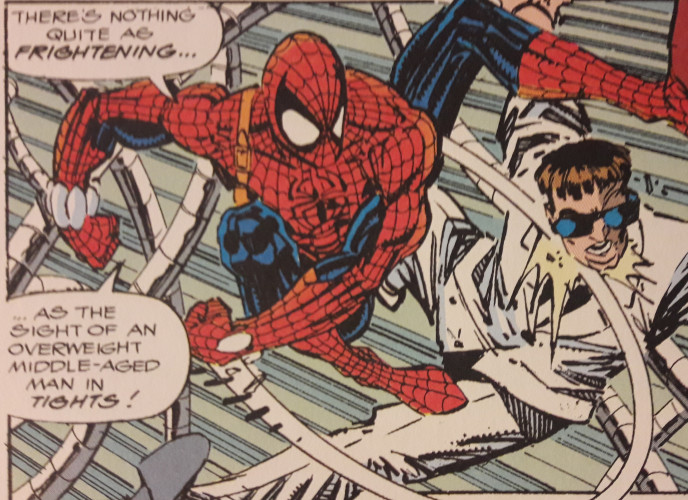
Plot-wise, Larsen seems to want to expound on Michelinie’s “Return” to the nth degree. In some ways, Larsen’s plot feels like a natural extension of “Return”: Doc Ock’s prior cronies–Electro, Mysterio, Vulture, Hobgoblin (still the demon-possessed Jason Macendale), and Sandman–plot vengeance upon the tentacled titan, who’d spurned them of a victory in the previous tale. Ock quickly turns the tables on his former friends and, being the kind-hearted shepherd of men he’s so clearly remembered as, ushers them back into the fold.
There’s very little that feels serious in this narrative…in fact, though Larsen attempts to add some edge to the Six (they’re collectively responsible for several hundred murders while they take steps towards world domination), most of the tale feels cartoony in nature. The Six pack oodles of heat stolen from another dimension, whose denizens they eradicate; Doc Ock nearly beats the Hulk to death with his new adamantium arms; the group at one point escapes a fight via a spaceship. It’s big, brash, in-your-face moments of sheer insanity…and none of it comes across as either uber dark or deeply hilarious. And yet, tonally, I don’t mind.
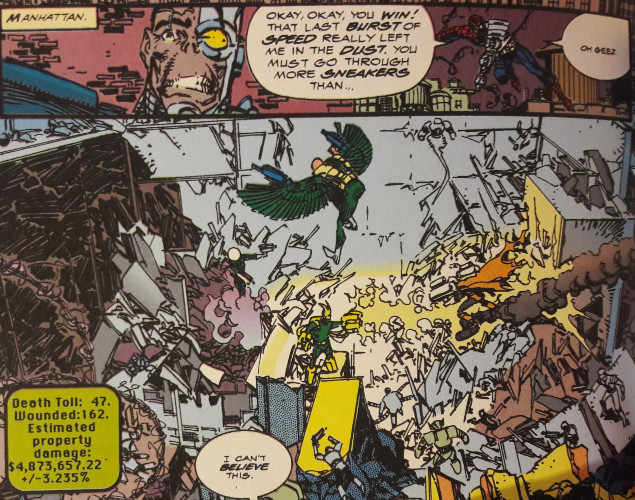
I tend to throw some derision on tales which seek a certain tone and then go way over the top to provide that tone. Deaths and death tolls are extreme, villains pack incredible firepower, costumes are dark and have spikes along the shoulders and arms…it’s that crazy 90s vibe that wants to be taken seriously but ends up feeling hokey. But…“Revenge” doesn’t feel like that. Or at least, I never felt like deriding it or laughing at it because it is silly. Larsen doesn't necessarily treat the story with kid gloves–I think, if you’re trying to level up your main supervillains, having them indiscriminately murder several hundred people is a surefire way to reach that goal–but these moments feel so out of place that they’re hard to treat with the weight they deserve. Some part of my brain just disconnects from knowing that the Vulture, of all people, is suddenly responsible for scores of deaths. The goofy old guy in the bird costume has the blood of hundreds on his liver-spotted hands? It doesn’t feel real.
But I don’t dislike it even if I can’t wrap my head around the concept. Maybe because it’s so bizarre and unsettling that I can’t allow myself to sit in the reality of what the Six actually do in this story…and, due to the pacing, Larsen doesn’t seem all that interested in letting the harsh truth sink in. He somewhat glosses over the sheer carnage our villains cause across these six chapters. We move from action set piece to action set piece (and I’ll discuss the moments where we do breathe later), with fights occurring not just between Spidey and his famed adversaries but between the Six and Hydra goons, the Six and several assembled superheroes (including the Hulk, Deathlok, Ghost Rider, Solo Nova, and the Fantastic Four), and Spidey and Ghost Rider against a weird cyborg who periodically pops up. It’s not supposed to be funny, it’s supposed to be weighty, but even if Larsen doesn’t deliver the philosophical or moral heft this tale intends to carry, I have a hard time blaming him for failing because I can revel in the goofiness masking the darkness.
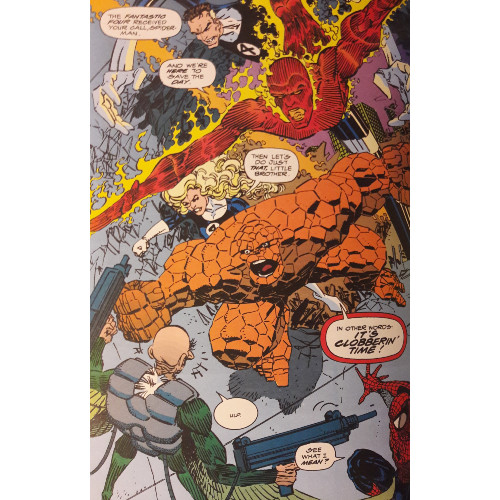
Admittedly, I may have just gotten so tired of McFarlane’s attempts at deeply serious narratives that I feel I can breathe a little easier by sidelining the darker aspects of Larsen’s story. McFarlane tried hard, really hard, to make you accept the brutality of a monstrous Lizard, the horror of a child-murdering monster, the revulsion of a living vampire slumming it in the sewers, or even the grim piety of a demon-infused supervillain. McFarlane was full of great ideas…but his vision was outclassed by his inability to make his ideas tangible. Not so Larsen. He promises a big ole’ bash of heroes and villains colliding and delivers. Yes, it means that the story itself often feels constantly accelerated, speeding along as punches are thrown, buildings blown up, and villains threaten heroes at the top of their lungs. But it’s a welcome change of pace from the philosophically blunt manner in which McFarlane attempted to elevate the title.
Occasionally, Larsen seems to mix in some concepts simply because had a really cool visual idea he wanted to try out–Spidey is injured and given a cast that makes him look like a cyborg; Doc Ock tests his new arms out on a legion of robots; a new dimension is briefly shown after the Six’s raid. But, to Larsen’s credit, ideas feel tethered more concretely together than when McFarlane was on the title. Not everything works perfectly–the “Spidey cyborg” bit is intended to be a bit of a jumpscare to make you temporarily believe our hero’s been fused with mechanical tidbits like Darth Vader. For the most part, fortunately, Larsen integrates his visuals and narration, largely foregoing shock and surprise for the sake of sensationalism.
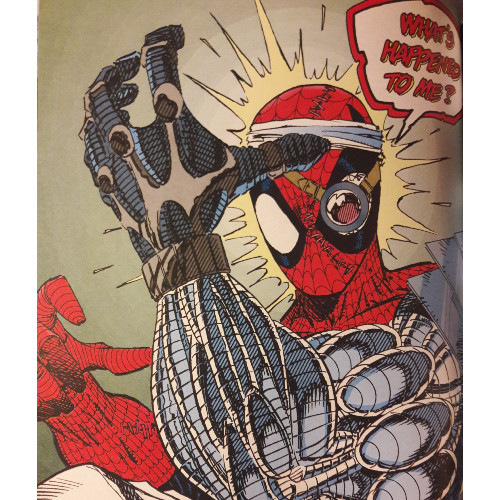
While Larsen’s bombastic, boisterous tone fits the fight sequences and supervillain shenanigans, he fails to deliver compelling character moments, particularly with Mary Jane. He’s not the first writer to fail her as a character. Both McFarlane in this “adjectiveless” title and Christopher Priest in a Spectacular Spider-Man annual did Mrs. Parker a disservice, failing to capture the spirit of the character (as showcased, conversely, in David Michelinie’s Amazing Spider-Man “wedding” annual and his “Return of the Sinister Six” arc). Larsen continues that trend here, threading in an obnoxious subplot where an argument between Peter and MJ is sparked by a petty disagreement over a role Peter wants MJ to reject.
You understand Larsen’s attempt at injecting tension and making MJ a character separate from her consistent worrying over Peter…and commenting on or continually constructing her career is an admirable way to do so. But the specific circumstances create what seems like quick and defensive responses from both parties, with neither side capable of seeing the other's point of view. Larsen throws in an additional subplot where MJ suddenly remembers Peter’s birthday is approaching and throws him a surprise party…which is supposed to bring catharsis to their squabbling? It’s rushed and out-of-the-blue and smacks of Larsen simply trying to squeeze MJ in because she's an important cast member rather than deserving of actual development. Again, he's not the first writer to do so.

“Revenge” is fairly easy to compare to its predecessor, “Return.” Both feature the reformation of the (subjectively) greatest team of supervillains to ever walk the planet; both feature of a Who’s Who of heroes aligned to end their scheming (it should be noted that Larsen incorporates his extended cast far more smoothly than Michelinie in “Return,” save for a minor contrivance or two, only inconveniencing readers tired of Spidey's seemingly constant 90s team-ups of late); and both feature over-the-top action woven in with some grounded character moments. Though Michelinie surpasses Larsen in the “grounded characterization department,” particularly where MJ is concerned, Larsen has no qualms about what kind of story he’s presenting. If you want to cling to shadowy machinations of our sinister sextet, go ahead. But if you want to see past the grim exterior to revel in the chewy center, you’re welcome to latch onto the raucous rambunctiousness instead.